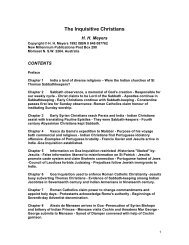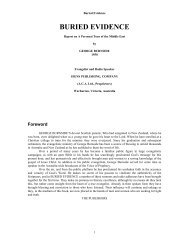Battle of the Bibles - Present Truth
Battle of the Bibles - Present Truth
Battle of the Bibles - Present Truth
You also want an ePaper? Increase the reach of your titles
YUMPU automatically turns print PDFs into web optimized ePapers that Google loves.
Finisterre in North Western Spain to Sicily were converted into a vast ship-building yard<br />
("Hume", Vol. II, Chapter 42).<br />
No doubt, <strong>the</strong> huge shipyards <strong>of</strong> Goa and lesser Portuguese ports in India and<br />
Ceylon also resounded to <strong>the</strong> sounds <strong>of</strong> axe and hammer on <strong>the</strong> magnificent teak timber<br />
used in <strong>the</strong> construction <strong>of</strong> <strong>the</strong> world's finest ships.<br />
Plans for <strong>the</strong> invasion called for no less than one hundred and thirty vessels,<br />
great and small. Close tells us that <strong>the</strong> huge galleons were "<strong>of</strong> great capacity and<br />
amazing strength. Their strong ribs were lined with planks four feet in thickness, through<br />
which it was thought impossible that cannon ball could pierce ".<br />
There were sixty-four <strong>of</strong> <strong>the</strong>se huge, cumbersome galleons which towered like<br />
castles above <strong>the</strong> waves. Most were heavily armed with large brass cannon. Besides <strong>the</strong><br />
normal complement <strong>of</strong> sailors, <strong>the</strong>re was provision for quartering soldiers and even<br />
supplying comfortable quarters for <strong>the</strong> pope's spiritual army <strong>of</strong> monks and friars.<br />
Then <strong>the</strong>re were <strong>the</strong> fearsome galleasses, <strong>the</strong> highly manoeuvrable destroyers<br />
capable <strong>of</strong> being speedily propelled by <strong>the</strong> oars <strong>of</strong> three hundred galley slaves, many <strong>of</strong><br />
whom were serving sentences meted out by <strong>the</strong> pope's Inquisitors.<br />
Built into <strong>the</strong> prow <strong>of</strong> <strong>the</strong>se boats was a malevolent-looking espalone, tipped with<br />
a large iron spike for ramming and piercing <strong>the</strong> hulls <strong>of</strong> enemy ships. Armed with<br />
formidable cannon, <strong>the</strong>y were <strong>the</strong> spearhead <strong>of</strong> <strong>the</strong> squadron which would grapple with<br />
<strong>the</strong> enemy, enabling <strong>the</strong>ir soldiers to swarm aboard, wreaking havoc with <strong>the</strong>ir swords<br />
and fearsome halberds (a combination <strong>of</strong> spear and battle axe).<br />
Besides <strong>the</strong> eight thousand soldiers needed for this fearsome armada, <strong>the</strong>re<br />
would be needed 2,088 galley slaves and 20,000 soldiers. But <strong>the</strong> spacious galleons<br />
could still provide ample room to adequately accommodate <strong>the</strong> numerous "noblemen<br />
and gentlemen" who were keen to obtain <strong>the</strong> pope's "blessing" by volunteering <strong>the</strong>ir<br />
services for <strong>the</strong> humbling <strong>of</strong> England.<br />
But this was not all! To this, <strong>the</strong> greatest sea-borne invasion force ever<br />
assembled, was to be added yet ano<strong>the</strong>r fleet! It was to be built and launched in <strong>the</strong><br />
ports <strong>of</strong> <strong>the</strong> Ne<strong>the</strong>rlands by Philip's new governor <strong>of</strong> <strong>the</strong> Lowlands, <strong>the</strong> Duke <strong>of</strong> Parma,<br />
who was widely regarded as <strong>the</strong> "ablest general <strong>of</strong> <strong>the</strong> age".<br />
This second armada would consist <strong>of</strong> some four hundred vessels, large and<br />
small, which would meet up with <strong>the</strong> main armada as it lay <strong>of</strong>f <strong>the</strong> coast at Calais. Not<br />
only would it reinforce <strong>the</strong> main fleet but it would be used for ferrying soldiers and<br />
supplies across <strong>the</strong> English Channel.<br />
As <strong>the</strong> time for <strong>the</strong> invasion approached, Parma had assembled an impressive<br />
polyglot army in <strong>the</strong> Channel ports. Close gives some details revealing <strong>the</strong> divided<br />
loyalties <strong>of</strong> <strong>the</strong> times:<br />
"There were thirty regiments <strong>of</strong> Italians, ten <strong>of</strong> Walloons, eight <strong>of</strong> Roman Catholic<br />
Scots and eight <strong>of</strong> Burgundians. Near Dixmuyde were mustered eighty regiments <strong>of</strong><br />
Dutch, sixty <strong>of</strong> Spaniards, six <strong>of</strong> Germans, and seven <strong>of</strong> English fugitives under <strong>the</strong><br />
command <strong>of</strong> Sir William Stanley ... quite a flock <strong>of</strong> Italian and Neapolitan princes and<br />
counts repaired to his [Parma's] banners. Believing that <strong>the</strong> last hour <strong>of</strong> England had<br />
come, <strong>the</strong>y had assembled to witness her fall " ("The Defeat <strong>of</strong> <strong>the</strong> Spanish Armada", p<br />
43).<br />
Lest any <strong>of</strong> our readers be unconvinced <strong>of</strong> <strong>the</strong> papal component <strong>of</strong> this "holy"<br />
enterprise to finish "heretical" England, it is pertinent to note that <strong>the</strong> eventual<br />
complement <strong>of</strong> men included <strong>the</strong> Vicar-General <strong>of</strong> <strong>the</strong> Holy Office <strong>of</strong> <strong>the</strong> Inquisition,<br />
accompanied by two hundred Dominican Friars. As it was this Dominican Order that <strong>the</strong><br />
4





